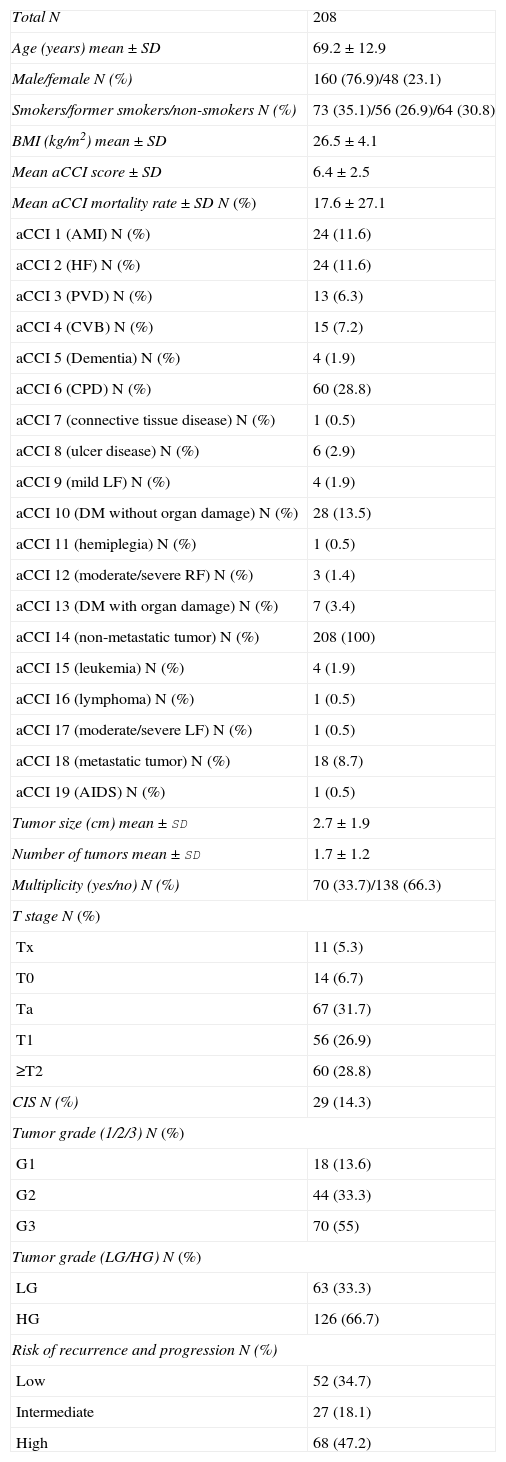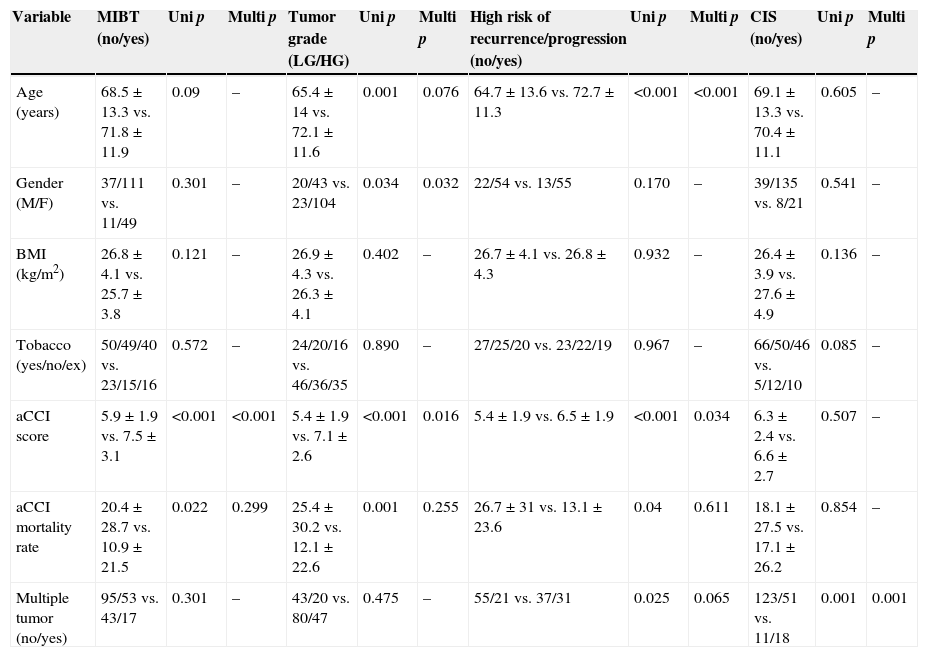To analyze the relationship between the age-adjusted Charlson comorbidity index (aCCI) and pathological outcomes of transurethral resection of de novo bladder tumors (BT).
Material and methodsData from 208 patients who underwent a transurethral resection (TUR) of a de novo BT between 2007 and 2008 were collected. We recorded the following variables: age, sex, tobacco consumption, comorbidities assessed according to the aCCI (score and mortality rate), disease stage, tumor grade and risk of recurrence and progression. The relationship between the preoperative variables and the final pathological characteristics was analyzed. The multivariate study was conducted with the significant variables (p<.05) from the univariate analysis.
ResultsThe mean age of the patients was 69.5±12 years, and 77% were men. The mean aCCI was 6.4±2.5. The final pathology results showed a Tx, T0, Ta, T1 and ≥T2 in 5.3, 6.7, 31.7, 26.9, and 28.8% of the cases, respectively. 33.3% of the tumors were low-grade and 66.7% were high-grade. 14.3% of the tumors were associated with carcinoma in situ. Among those non musculo-invasive bladder tumor (non-MIBT), 34.7% had a low risk of recurrence and progression, 18.1% had an intermediate risk and 47.2% had a high risk.
The patients with a aCCI ≥5 had an increased number of MIBT (RR: 2.29; 1.1–4.8; p=.032), high-grade tumors (RR: 3.1; CI: 1.6–6; p=.001) and tumors with a high risk of recurrence and progression (RR: 2.9; CI: 1.4–5.9; p<.001).
ConclusionThe aCCI is related to the pathological characteristics of de novo BT. Patients with greater comorbidity can present more aggressive tumors. The aCCI could therefore be useful in clinical practice for identifying patients with worse prognosis.
Analizar la relación entre el índice de comorbilidad de Charlson ajustado por edad (ICCa) y los resultados anatomopatológicos de las resecciones transuretrales (RTU) de tumores vesicales (TV) de novo.
Material y métodosSe recogieron los datos de 208 pacientes que, entre 2007 y 2008, fueron tratados mediante una RTU de un TV de novo. Se recogieron las variables edad, género, consumo de tabaco, comorbilidades evaluadas según el ICCa (puntuación y tasa de mortalidad), estadio patológico, grado tumoral y riesgo de recurrencia y progresión. Se analizó la relación entre las variables preoperatorias y las características patológicas finales. Se realizó el estudio multivariante con aquellas variables significativas (p<0,05) en el análisis univariante.
ResultadosLa edad media fue 69,5±12. Un 77% fueron hombres. El ICCa medio fue 6,4±2,5. El resultado anatomopatológico final mostró un Tx, T0, Ta, T1 y T≥2 en el 5,3; 6,7; 31,7; 26,9 y 28,8%, respectivamente. El 33,3% fueron de bajo grado y el 66,7% de alto grado. Un 14,3% se asoció con CIS. Entre los TV no músculo invasivos, el 34,7% fueron de bajo riesgo de recurrencia y progresión, el 18,1% intermedio y el 47,2% de alto riesgo.
Los pacientes con un ICCa igual o superior a 5 presentaron un mayor número de TV músculo invasivos (RR: 2,29; 1,1–4,8; p=0,032), de tumores de alto grado (RR 3,1; IC: 1.6–6; p=0,001) y de tumores de alto riesgo de recurrencia y progresión (RR: 2,9; IC: 1,4–5,9; p<0,001).
ConclusiónEl ICCa está relacionado con las características patológicas de los TV de novo. Pacientes con mayor comorbilidad pueden presentar tumores más agresivos, por lo que el ICCa podría ser útil en la práctica clínica al identificar a pacientes con peor pronóstico.








